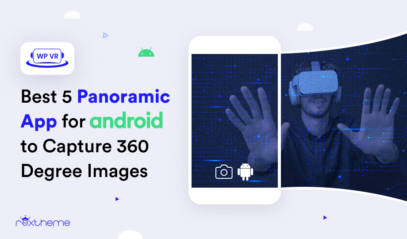I know a few friends of mine who started using virtual reality in their business and projects years ago. One of them works in gaming and relies on fully immersive VR to create deep, interactive experiences.
Another is in real estate, using non-immersive VR to offer virtual property tours that clients can explore on their own devices.
And the third runs an education program, where semi-immersive VR helps students engage with lessons in a more interactive but accessible way.
Over time, I’ve seen what worked for them and what didn’t. And honestly, one mistake keeps coming up that people jump into VR without knowing which type they actually need.
You might be thinking, “VR sounds cool, let’s try it.” And sure, it is. But picking the wrong type can waste your time and money.
Some people go for a big VR setup when something simple would’ve done the job better.
Right now, over 171 million people use VR worldwide.
But not all VR works the same for everyone.
So in this guide, I’ll show you the 5 main types of Virtual Reality, when to use each, and how to choose the one that fits you best.
Let’s get started.
TL:DR Types of Virtual Reality
- Virtual reality (VR) helps users explore simulated environments that feel real using tools like HMDs, motion sensors, and powerful computers.
- There are 5 different types of VR used across industries, depending on the level of immersion and interaction needed.
- According to Grand View Research, the global VR market is projected to reach over $435.36 billion by 2030, as more industries adopt tailored VR types.
- Here’s a quick breakdown of the 5 major VR types:
– Non-Immersive VR: Ideal for real estate tours, basic training; runs on regular screens.
– Fully Immersive VR: Best for pilot training, surgical simulations, and VR games using headsets and motion tracking.
– Semi-Immersive VR: Used in aviation and education through flight simulators and projected environments.
– Augmented Reality (AR): Blends virtual elements into real life, often used in retail and product demos.
– Collaborative VR: Used for virtual meetings and group training in industries like game development and remote learning. - A good virtual tour solution for non-immersive VR is WPVR, especially if you run a WordPress site.
- Final Note: Choosing the right VR type depends on your industry, purpose, and tech setup. Start with the simplest that fits your need, then scale.
What is Virtual Reality & How It Works?
Virtual Reality refers to creating a realistic experience that does not exist in reality. It is a virtual experience that you can observe, listen to, and interact with, but cannot touch.

For example, imagine you’re sitting at home, but through a VR headset, you feel like you’re walking inside a hotel or taking a ride in a new car. You can look around and explore, just like you’re really there.
People now use VR in many smart ways, like training doctors, learning new skills, playing games, or showing homes to buyers online. Businesses in real estate, education, travel, and even the army are getting results using VR.
For example, Porsche lets people test drive their latest car through VR. You can check the design, the interior, and how it feels, all without visiting the showroom.
VR is also getting better with the help of machine learning. It helps create smarter, more realistic experiences based on how users move or react.
5 Different Types of Virtual Reality
To find the right type of virtual reality that matches your needs, You need to know the best ones among all the VR types.
Among tons of VR formats, pick one among these 5 innovative virtual reality types.
- Non-immersive Virtual Reality.
- Fully Immersive Virtual Reality.
- Semi-Immersive Virtual Reality.
- Augmented Reality.
- Collaborative VR.
Now let’s learn in-depth one by one:
1. Non-immersive Virtual Reality
Non-immersive virtual reality is a virtual experience through a desktop. You can control characters or activities within the software.
You can also find a power-packed laptop for virtual machines and work on the go.
Since more and more people appreciate mobility, manufacturers create powerful systems in compact bodies.
For example, when you play video games such as World of WarCraft, you can control characters within the game that have their own animations and attributes.
(Interestingly, over the years, several science conferences have been held within the World of Warcraft ‘world’. Utilizing the platform instead of a traditional web conferencing system, while creating an innovative experience for members. This, of course, has its benefits compared to traditional means.)
Technically, you are dealing with a virtual world, but you are not the center of attention in the game. All actions or features interact with the characters within.

All basic forms of gaming devices, such as PlayStation, Xbox, Computer, other video game consoles, and even input devices such as mice and keyboards etc, provide you with a non-immersive virtual reality experience.
The US Defence Force suggested that strategic games can help to develop the planning and strategic expertise of the US Army back in 2017. This has been put to effective use since the Summer of 2018.
2. Fully Immersive Virtual Reality
Contrary to non-immersive virtual reality, fully immersive virtual technology ensures that you have a realistic experience within the virtual world.
It’ll give you a sense of being present in that virtual world, and everything is happening to you for real.
- Here is a more detailed guide on what is immersive virtual reality
This is an expensive form of virtual reality that involves helmets, gloves, and body connectors with sense detectors.
These are connected to a powerful computer. Your movements, reactions, and even a blink of an eye are detected and projected within the virtual world.
You will feel like you are within the virtual world physically.
One example could be playing Half-Life: Alyx, a fully immersive VR game where you wear a VR headset and use motion controllers to interact with a realistic 3D world.
You can physically move around, pick up objects, shoot enemies, and solve puzzles — all by using natural hand and body movements inside the game environment.
A new concept of virtual medical training is being looked at to train neurosurgeons to avoid disasters during risky brain operations.
Another potential fully immersive virtual reality that’s becoming popular nowadays is transforming the education sector.
Many more such concepts are coming to life and hopefully will result in making our lives better. Fully immersive virtual reality is costly and not widely created yet.
3. Semi-immersive Virtual Reality
A semi-immersive virtual reality is a mixture of non-immersive and fully immersive virtual reality.
This can be in the form of a 3D space or virtual environment where you can move about on your own, either through a computer screen or a VR box/headset. So all activities within the virtual world are concentrated toward you.
However, you have no real physical movements other than your visual experience.
On a computer, you can use the mouse to move about the virtual space, and on mobile devices, you can touch and swipe to move about the place.

Most semi-immersive virtual environments support Gyroscope, which means the virtual space will be fixed on your phone based on the vertical axis, and you have to literally move your phone about in different directions to view the virtual environment in those directions.
Swiping will not work.
The ones that are connected to VR boxes are more interactive since they are also a form of Gyroscope, but without you using your hands.
When you wear a VR box/headset, you will only be able to see the virtual environment and not your real world, even from the corner of your eye. Thus creating a realistic experience.
Semi-immersive virtual reality is the most cost-effective and commonly used among all forms of virtual reality after non-immersive VR. It’s especially used for training and educational purposes.
It can be used to provide students with immersive, interactive educational experiences like exploration of historical events, distant planets, and even scouting oceans from the classroom. Ultimately, helping teachers to teach more engagingly and realistically rather than sticking to theoretical explanations only.
A virtual tour is the most popular semi-immersive virtual reality that most businesses are embracing today. They can be both device-based and web-based. Overall, they provide an interactive virtual experience.
It is mostly used in businesses such as real estate websites, hotels, local bars or pubs, universities, schools, and many more businesses that rely on highlighting and promoting their locations
4. Augmented Reality
Augmented Reality is when a certain entity or device seems to be present in reality but is actually not. Rather than putting you into a virtual world, a virtual entity is placed in the real world through any device.
For example, through your mobile screen, you can view your room and probably place a cartoon character in the corner. You will be able to see the character through your mobile screen and not in reality.
It is mostly used by businesses such as furniture suppliers or decorators.
For example, a person willing to buy a table will be able to place the table in his room through his phone display. This will let him understand if this table is suitable and looks good in his room, or if he has to choose another design.
Augmented reality is often argued to be a unique form of technology rather than VR. There are also a few technology consulting services that often assist in implementing augmented reality solutions effectively.
But its ability to place entities virtually often puts it within the VR category. Watch this video to understand the difference of virtual reality vs Augmented Reality:
5. Collaborative VR
This is a form of a virtual world where different people from various locations can come into contact within a virtual environment, usually in the form of 3D or projected characters.

For example, Unity game development has also embraced the concept of virtual collaboration, much like the video game called PUBG (Players Unknown Battlegrounds), where tons of players come into existence as individual virtual characters that they can control.
Similarly, the integration of hybrid casual elements in virtual reality games is becoming increasingly popular, offering a unique blend of simplicity and engagement.
Much like the transformative impact of igaming development in its sector, VR technologies are paving the way for innovative experiences across various domains.
Here, they can interact with each other through microphones, headsets, and chat.
Recently, people have been getting used to virtual meeting rooms to conduct business meetings remotely or to conduct virtual debate competitions.
For those interested in enhancing their virtual collaboration, learning how to conduct virtual meetings effectively is crucial, offering a blend of convenience and efficiency in today’s digital landscape.
Exploring AR VR development services can significantly enhance these virtual experiences. The main goal of this form of VR is to create collaboration between people.
As virtual reality continues to improve over time, the advancement of translation for VR will pave the way for immersive multilingual experiences.
How Different Industries Use Different Types of Virtual Reality
Now, let’s look at how different industries are using various types of VR to solve real problems, enhance experiences, and drive innovation.
- Real Estate: Real estate uses non-immersive VR and virtual tours to help buyers explore homes remotely. These virtual tours rely on motion tracking and 3D virtual worlds. It makes your property viewing easier and more interactive.
- Healthcare: Healthcare applies fully immersive VR for surgical training and patient therapy. Powerful computers and haptic technology create realistic, safe practice environments. This helps you to improve skills without any risk.
- Aviation: Aviation uses semi-immersive VR flight simulators for pilot training. Motion sensors and gyroscopes help replicate real flying conditions. This helps pilots train at the highest level before actual flights.
- Education: Education uses virtual reality for virtual field trips and collaborative learning. Students explore wide fields and simulated environments together. This new technology makes learning more engaging and immersive. Here is a guide on how education uses virtual reality and what the future holds in this industry.
- Retail & Automotive: Retail and automotive industries use augmented reality and 3D virtual worlds to showcase products. Customers can customize and test items virtually using smartphones or VR headsets. This improves customer experience and sales.
- Entertainment: Entertainment offers VR games, VR movies, and PlayStation VR for immersive fun. Haptic feedback and motion tracking increase realism. These VR applications make gaming and movies more exciting.
The Perfect Tool to Make a Virtual Tour
Now think and choose what type of virtual reality you want to experience. I know what you are thinking.
How can you make a virtual tour right?
Making a virtual tour can sound too complex. But by using WPVR, you can do it very easily with just 3 steps.
![5 Types Of Virtual Reality – Get The Perfect VR Solution [2025] 1](https://rextheme.com/wp-content/uploads/2023/09/Add-New-Virtual-Tour-WPVR.webp)
First, take 360° panorama images, and then :
- Connect these Panorama Scenes
- Use Scene-type Hotspots so all the 360-degree images join together
- Show information in the virtual tours using info hotspots and hit publish!
And that’s it, you’ve created your desired virtual tour.
You can share your virtual tour on social media very easily.
Using WPVR you can easily share your 360-degree virtual tours on your desired Social Media Platforms like
- Facebook,
- LinkedIn,
- Twitter,
- Email, and
- Reddit.
not just that you can generate a QR Code automatically for your virtual tour and send it anywhere, but you too can view or show your virtual tour without any web page.
You also don’t have to worry about how to do the plugin installation and activation process, as we have created 82 pieces of documentation from installation to all the major settings, step by step.
Go through the WPVR Documentation.
- If you want to learn by watching YouTube videos, we have a complete playlist on WPVR
- You can also check out this article: Complete Guide to Create a Virtual Tour.
Conclusion
Virtual Reality is no longer just a trend; it’s a smart tool being used across many industries. From training to sales, it’s changing how we connect and engage.
Each type of VR offers a unique experience, and choosing the right one can help you achieve your specific goals more effectively.
More businesses are using VR for virtual tours, product demos, and online meetings to boost interaction and stand out in a crowded market.
If you’re ready to explore VR, start simple. Try WPVR to easily create immersive virtual tours right from your WordPress site, no complex setup needed.
** FAQs **
What devices are used to experience VR?
- Virtual Reality works through gadgets like HMDs, HTC Vive, PlayStation VR, and standalone VR headsets. These devices use motion sensors, gyroscopes, and input tracking to detect your movement. Together, they create a smooth, interactive experience inside a 3D virtual world.
Is VR only used for gaming?
- While VR games are popular, VR is also used in pilot training, surgical training, virtual field trips, and more. These VR applications help users learn, train, or explore without being physically present. So no, VR is far more than just entertainment.
What makes fully-immersive VR feel real?
- Fully-immersive VR combines motion tracking, haptic feedback, and powerful computers to simulate real-world interactions. These create a responsive simulated environment that adjusts to your actions. It gives the highest level of realism and a deeply engaging user experience.
Can I use a smartphone for VR?
- Yes, many VR applications work on smartphones with basic headsets for simple experiences. But for better VR usage, devices with advanced computer technology and motion sensors give smoother visuals. They also improve tracking accuracy and overall user comfort.
What are commercial virtual reality systems?
- Commercial VR systems are powerful tools businesses use to train teams and show products in a real way. They use headsets, motion sensors, and strong computers to make the experience feel real. You’ll find them in places like hospitals, real estate, pilot training, and schools
![5 Types Of Virtual Reality – Get The Perfect VR Solution [2025]](https://rextheme.com/wp-content/uploads/2024/06/Types-Of-Virtual-Reality-–-Creating-A-Better-Future.webp)



Great to know that you’re very fascinated with the beauty of Virtual Reality as much as I do! This is the reason I keep on looking forward for the future improvements of the VR technology because there is a lot of space for creative minds in the VR world. One thing I like about the Virtual Reality is being able to create a Virtual Tour.
Hi April,
It’s really great to have someone who shares the same interests.
I’ll suggest you to read our other articles on Virtual Reality as well.
Regards,
I’m more than happy to discover this great site.
I wanted to thank you for your time just for this fantastic read!!
I definitely really liked every bit of it and I have you bookmarked to check out new things in your blog.
Hi Cassius,
I’m delighted to know that you enjoyed this article.
If you’re interested, we have more guides on similar topics:
A detailed list of answers for your every question about virtual tours: https://rextheme.com/what-is-a-virtual-tour-learn-all-about-virtual-tours/
How you can make a virtual tour with iPhone panorama images: https://rextheme.com/how-to-make-a-virtual-tour-with-iphone-panorama/
I hope you’ll love these as well.
Regards,
Great article on the subject of virtual reality, everything is clear and clearly written.
Thank you. Perhaps you will also enjoy the following article:
Cheers.
Whenever I read your articles, I like it very much, you keep writing articles like this
Thank you so much!
Sure, we’ll come up with more articles like this.
appreciate this list.
Thank you.
Good good
Thank you!
A good job.
Thank you
Oh! Really looking for this
Thank you.
In today’s interconnected world, technology plays a central role in our lives.
Hi Verma,
Yes, you’re right.
Great article! Virtual reality is truly revolutionizing the way we experience and interact with the world. The different types of virtual reality mentioned here provide a comprehensive overview of the possibilities and applications of this technology. It’s exciting to see how industries are leveraging virtual reality to enhance their businesses and create immersive experiences for users. Looking forward to seeing what the future holds for virtual reality!
Hey Timothy,
That’s a great perspective!
We hope to look forward to it too.
Regards,
I am very happy to find your blog with super informational, effective blog.
Hello, We’re really glad that you found our article helpful.
Cheers.
Your Content about Virtual Reality is good. I read the full content and I am also working on content creation similar to the subject. Thanks for the well-written details on VR.
Hi, I’m glad to hear that you took the time to read the entire article and found it helpful. It would inspire us to bring more new helpful content in future.
Cheers.
How Can I get more information about VR from you. thanks for your swift
response.
Hi Tesfahun,
Please reach out to [email protected] if you want to learn about our VR Tool.
And if you’d like to know more VR. Please check out the following guides,
1. https://rextheme.com/create-virtual-tour-complete-guide/
2. https://rextheme.com/real-estate-virtual-tour/
Cheers.
Greetings! Very helpful advice within this article! It is the little changes that produce the largest changes. Many thanks for sharing!
Hi There,
We appreciate you letting us know that you enjoyed our article.
There’s definitely a lot to know about this issue. I really like all the points you made.
Hi, thanks for letting us know. It’s great that you liked our article.
Virtual reality is truely immersive, engaging, and memorable.
Good article
This overview of virtual reality types is very helpful. It’s exciting to see how VR is changing and being used in different areas.
Thank you for your valuable input.
VR revolutionizes the way people interact with technology by creating seamless, immersive digital experiences that leave a lasting impact.
Great detailed article!
Thank you so much!
This is a good tip especially to those fresh to the blogosphere. Brief but very accurate info… Appreciate your sharing this one. A must read article!
Hi There,
Thank you so much!